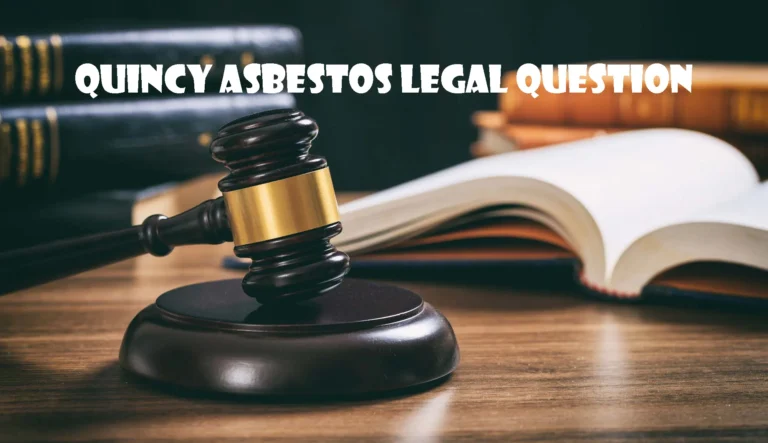In this article, we are providing all the information about the Quincy Asbestos Legal Question. Asbestos, once hailed for its versatility and fire-resistant properties, has since become synonymous with a myriad of health risks and legal complexities. The mere mention of asbestos evokes images of caution tape, protective suits, and lengthy court battles. In the city of Quincy, a legal question looms large, casting a shadow over the community and raising important concerns about accountability and justice.
As we delve into the intricate web of asbestos-related issues in Quincy, it becomes evident that this is not just a legal matter but a deeply personal one that affects the lives and well-being of individuals within the community. Join me on this journey as we unravel the layers of complexity surrounding the Quincy asbestos legal question and seek to shed light on everything you need to know.
A. Background information on asbestos exposure and related health risks
Asbestos exposure has been a significant public health concern for decades due to its harmful effects on human health. Asbestos is a naturally occurring mineral that was widely used in various industries for its heat-resistant and insulating properties. However, when asbestos-containing materials are disturbed or damaged, tiny asbestos fibers can be released into the air and inhaled, leading to serious health risks.
Exposure to asbestos has been linked to various respiratory conditions such as asbestosis, lung cancer, and mesothelioma – a rare but aggressive form of cancer that primarily affects the lining of the lungs and abdomen. The latency period between asbestos exposure and the development of related diseases can span several years or even decades, making it challenging to diagnose and treat effectively. As a result, individuals who have been exposed to asbestos either occupationally or environmentally may face long-term health consequences that can significantly impact their quality of life. Understanding the dangers associated with asbestos exposure is crucial in order to protect oneself and seek appropriate legal recourse if necessary.
B. Overview of the legal implications surrounding asbestos cases
Asbestos cases have long been a complex and contentious issue within the legal realm due to the severe health risks associated with exposure to this harmful mineral. The legal implications surrounding asbestos cases are multifaceted, involving various parties such as individuals, companies, and even government entities. One of the key aspects of these cases is determining liability, as individuals who have been exposed to asbestos and subsequently developed health issues may seek compensation for damages incurred.
Moreover, asbestos litigation often involves intricate legal procedures and specialized knowledge due to the long latency period between exposure and the manifestation of related illnesses like mesothelioma or lung cancer. Additionally, statutes of limitations play a crucial role in these cases, as they determine the timeframe within which individuals can file claims. Understanding the legal implications surrounding asbestos cases is essential for both victims seeking justice and legal professionals navigating this intricate area of law.
I. What are Quincy Asbestos Legal Questions
Quincy Asbestos Legal Question involves understanding the legal complexities surrounding asbestos exposure and related health issues. Here are ten common questions about the Quincy Asbestos legal and their corresponding answers:
Question: What are the legal implications of asbestos exposure in Quincy, Massachusetts?
Answer: Asbestos exposure in Quincy can lead to legal actions due to its health hazards, potentially resulting in lawsuits against responsible parties.
Question: How can residents of Quincy determine if they have a legal case related to asbestos exposure?
Answer: Residents should consult with experienced asbestos attorneys in Quincy to evaluate their situation and determine the viability of a legal claim.
Question: What is the statute of limitations for filing an asbestos-related lawsuit in Quincy?
Answer: The statute of limitations for asbestos cases varies by state, but in Quincy, it typically ranges from one to six years from the time of diagnosis or discovery of the asbestos-related illness.
Question: Are there specific laws or regulations in Quincy regarding asbestos removal and disposal?
Answer: Yes, Quincy adheres to federal and state regulations for asbestos removal and disposal to ensure public safety and environmental protection.
Question: What types of compensation can victims of asbestos exposure pursue through legal action in Quincy?
Answer: Victims may seek compensation for medical expenses, lost wages, pain and suffering, and other damages resulting from asbestos-related illnesses.
Question: Can family members of individuals affected by asbestos-related diseases file lawsuits in Quincy?
Answer: Yes, family members may be eligible to file wrongful death claims or pursue legal action on behalf of their loved ones who have passed away due to asbestos-related illnesses.
Question: What role do asbestos trust funds play in legal proceedings in Quincy?
Answer: In order to compensate victims of asbestos exposure, bankrupt corporations set up asbestos trust funds. They can be an important source of compensation for individuals pursuing legal claims in Quincy.
Question: How long does it typically take to resolve an asbestos-related lawsuit in Quincy?
Answer: The timeline for resolving asbestos cases varies depending on factors such as the complexity of the case, the number of defendants involved, and court proceedings. It could last anywhere from a few months to a few years.
Question: Are there any government resources available to help residents of Quincy navigate asbestos-related legal matters?
Answer: Residents can contact local government agencies, such as the Massachusetts Department of Environmental Protection, for information and assistance regarding asbestos-related issues.
Question: What steps should individuals take if they suspect they have been exposed to asbestos in Quincy?
Answer: Individuals should seek medical attention immediately and then consult with a qualified asbestos attorney in Quincy to discuss their legal options and potential recourse.
II. Understanding Quincy Asbestos Legal Question
In Quincy, the asbestos legal question revolves around the responsibility and accountability of parties involved in exposing individuals to asbestos and the resulting health consequences. This specific legal issue in Quincy is significant due to the potential harm caused by asbestos exposure, which can lead to serious health conditions such as mesothelioma, lung cancer, and asbestosis. The legal question at hand seeks to address who should be held liable for these health risks and how justice can be served for those affected by asbestos exposure in Quincy.
Understanding the Quincy asbestos legal question requires delving into the complexities of proving negligence, determining liability, and seeking compensation for victims. It involves navigating through intricate legal processes to ensure that those impacted receive the support and justice they deserve. By shedding light on this specific legal matter in Quincy, we aim to provide clarity on the intricacies surrounding asbestos cases and empower individuals with knowledge to protect their rights and seek recourse when faced with similar challenges.
A. Overview of asbestos use in Quincy industries
Quincy, a city with a rich industrial history, has had a significant presence of asbestos in various industries over the years. Asbestos, valued for its heat resistance and durability, was extensively used in Quincy’s shipbuilding, manufacturing, and construction sectors. Workers in shipyards, factories, and construction sites were routinely exposed to asbestos fibers without being aware of the severe health risks associated with this mineral.
The use of asbestos in Quincy industries peaked during the mid-20th century when its harmful effects started to become more widely recognized. Unfortunately, many workers had already been exposed to asbestos-containing materials without proper protective measures in place. This exposure has led to numerous cases of mesothelioma, lung cancer, and other asbestos-related diseases among workers who were employed in Quincy’s industrial facilities. Understanding the historical context of asbestos use in Quincy is crucial for comprehending the legal implications and seeking justice for those affected by asbestos exposure.
B. Context of the situation in Quincy
In Quincy, the issue of asbestos exposure has become a pressing concern for residents and authorities alike. The presence of asbestos in buildings and structures poses a significant health risk to individuals who may come into contact with it. Asbestos, once a commonly used material in construction due to its fire-resistant properties, is now known to cause serious health problems such as lung cancer, mesothelioma, and asbestosis when its fibers are inhaled.
The specific legal question in Quincy revolves around who is responsible for addressing the asbestos problem and compensating those who have been affected by it. This includes determining liability for the presence of asbestos in buildings, ensuring proper removal procedures are followed to prevent further exposure, and seeking justice for individuals who have suffered health consequences due to asbestos exposure in Quincy. The resolution of this legal question will not only impact current cases but also set a precedent for how similar situations involving asbestos will be handled in the future.
III. Key parties involved in the legal question
In the Quincy asbestos legal question, there are several key parties involved that play crucial roles in shaping the outcome of the case. Firstly, the individuals who have been exposed to asbestos and subsequently developed health issues are at the heart of this legal matter. Their well-being and rights will be central to any decisions made regarding liability and compensation.
Another key party in this legal question is the companies or entities responsible for exposing individuals to asbestos. These could include manufacturers, employers, or property owners who failed to adequately protect people from asbestos exposure. Holding these parties accountable is essential in seeking justice for those affected by asbestos-related illnesses. Additionally, legal representatives on both sides will play pivotal roles in advocating for their clients and presenting evidence to support their respective positions. Understanding the dynamics between these key parties is essential in comprehending the complexities of the Quincy asbestos legal question.
A. Analysis of the potential outcomes and impacts of the legal question
When considering the potential outcomes and impacts of the Quincy asbestos legal question, it is crucial to recognize the far-reaching implications for individuals affected by asbestos exposure. The legal resolution of this case could have significant ramifications on the health and well-being of those who have been exposed to asbestos, potentially leading to compensation for medical expenses, lost wages, and pain and suffering. Moreover, a favorable outcome in this legal battle could set a precedent for future cases involving asbestos-related illnesses, establishing clearer guidelines for liability and accountability.
Examining the legal precedents and regulations relevant to the Quincy asbestos case sheds light on the complexities involved in navigating such intricate legal terrain. Understanding how past rulings and existing laws shape the current legal landscape is essential in predicting potential outcomes and crafting effective strategies moving forward. By delving into these precedents and regulations, we can gain valuable insights into how the legal system may interpret and address the complexities of asbestos exposure cases, ultimately influencing the direction in which justice is served for those impacted by this hazardous substance.
B. Discussion on the implications for individuals affected by asbestos exposure
Individuals affected by asbestos exposure face a myriad of challenges that can have long-lasting impacts on their health and well-being. From respiratory issues to more serious conditions like mesothelioma, the consequences of asbestos exposure are severe and often irreversible. Those who have been exposed to asbestos may experience symptoms years or even decades after initial exposure, making early detection and proper medical care crucial.
Moreover, the financial burden of medical treatments and ongoing care for asbestos-related illnesses can be overwhelming for individuals and their families. Seeking legal recourse through asbestos litigation can provide a means of holding responsible parties accountable for the harm caused by negligence or misconduct. By understanding the implications of asbestos exposure and the legal options available, individuals affected by this toxic substance can pursue justice and compensation to help alleviate some of the financial, mental, and physical hardships they could experience.
C. Examination of the legal precedents and regulations relevant to the case
In examining the legal precedents and regulations relevant to the Quincy asbestos case, it is crucial to consider the historical context of asbestos regulation in the United States. Asbestos has long been recognized as a hazardous material with severe health implications, leading to a series of regulatory measures aimed at protecting individuals from exposure. The Environmental Protection Agency (EPA) and the Occupational Safety and Health Administration (OSHA) have established guidelines for handling asbestos-containing materials, emphasizing the importance of proper containment and removal procedures to prevent harm.
Furthermore, legal precedents set by past asbestos-related cases have shaped the landscape of litigation surrounding asbestos exposure. Landmark cases such as Borel v. Fibreboard Corporation have established liability for companies that knowingly exposed individuals to asbestos without adequate warning or protection. These legal decisions serve as a foundation for holding parties accountable for their actions in cases where negligence or misconduct has resulted in harm to individuals exposed to asbestos. Understanding these precedents and regulations is essential in navigating the complexities of the Quincy asbestos legal question and seeking justice for those affected by this harmful substance.
IV. Legal Process and Challenges
Navigating the legal process surrounding asbestos-related cases can be complex and challenging due to various factors at play. One of the primary challenges is establishing a clear link between asbestos exposure and resulting health issues, which often requires thorough documentation and expert testimony. Additionally, determining liability can be a lengthy process as it may involve multiple parties such as manufacturers, employers, and property owners who may share responsibility for the exposure.
Moreover, the legal landscape regarding asbestos cases is constantly evolving with changing regulations and precedents that can impact the outcomes of such lawsuits. Understanding these legal nuances and staying abreast of any updates is crucial for both plaintiffs and defendants involved in these cases. Overall, engaging in the legal process related to asbestos requires patience, diligence, and a deep understanding of the complexities involved in order to navigate through potential challenges effectively.
A. Overview of the legal process involved in addressing asbestos-related cases
Asbestos-related cases in Quincy involve a complex legal process that requires a deep understanding of both the legal system and the medical aspects of asbestos exposure. When addressing such cases, it is crucial to first establish a clear link between exposure to asbestos and the resulting health issues. This often involves thorough investigations, medical examinations, and expert testimonies to build a strong case.
Once the connection is established, legal proceedings typically involve filing a lawsuit against the responsible parties, which can include manufacturers, employers, or property owners. The legal process may entail negotiations for settlements or litigation in court if an agreement cannot be reached. It is essential to work with experienced attorneys who specialize in asbestos cases to navigate this intricate legal terrain effectively and seek justice for those affected by asbestos exposure in Quincy.
B. Discussion on the complexities and nuances of navigating the legal system in Quincy
Navigating the legal system in Quincy when it comes to asbestos-related cases can be a complex and nuanced process. From understanding the specific laws and regulations governing asbestos exposure to determining liability and seeking compensation, there are various intricacies involved. It is crucial for individuals affected by asbestos exposure in Quincy to seek legal guidance from experienced attorneys who specialize in handling such cases. These legal professionals possess the knowledge and expertise required to navigate through the complexities of the legal system, ensuring that their client’s rights are protected and justice is served.
Furthermore, dealing with asbestos-related cases in Quincy may involve multiple parties, including property owners, employers, manufacturers, and insurance companies. Each entity may have its own set of responsibilities and legal obligations regarding asbestos exposure, adding another layer of complexity to the legal process. By working with skilled attorneys who are well-versed in Quincy’s legal landscape, individuals affected by asbestos exposure can effectively navigate these complexities and pursue the compensation they deserve.
V. Impact on Community and Public Health
As we delve into the Quincy Asbestos Legal Question, it becomes evident that the implications extend far beyond individual legal battles. The community at large is deeply affected by the presence of asbestos and the resulting legal proceedings. Not only does asbestos exposure pose serious health risks to individuals, but it also has broader public health implications that cannot be overlooked.
The impact of asbestos on public health is profound, as exposure to this harmful substance can lead to a range of serious respiratory illnesses, including asbestosis and mesothelioma. These diseases not only affect those directly exposed but also have ripple effects throughout the community. The need for comprehensive solutions to address asbestos-related issues in Quincy is crucial not just for individual cases but for safeguarding the well-being of the entire community.
A. Examination of the broader impact of the Quincy Asbestos Legal Question on the community
As we delve into the broader impact of the Quincy Asbestos Legal Question on the community, it becomes evident that the repercussions extend far beyond individual cases. The presence of asbestos in buildings and structures within Quincy raises concerns not only for those directly affected by exposure but also for the community at large. The potential health risks associated with asbestos exposure are a pressing issue that demands attention and action.
The community’s well-being is intricately linked to how effectively this legal question is addressed. Public health implications loom large as residents face uncertainties about their safety and future. It is imperative for stakeholders to collaborate, ensuring that comprehensive measures are taken to mitigate risks, provide support to those impacted, and prevent further harm. The Quincy Asbestos Legal Question serves as a stark reminder of the importance of safeguarding public health and underscores the need for proactive strategies to protect both current and future generations from the dangers posed by asbestos exposure.
B. Discussion on the public health implications of asbestos exposure
Asbestos exposure poses significant public health implications that cannot be overlooked in the context of the Quincy Asbestos Legal Question. The inhalation or ingestion of asbestos fibers can lead to serious health conditions, including lung cancer, mesothelioma, and asbestosis. These diseases often have a long latency period, meaning symptoms may not manifest until years after initial exposure. This delayed onset further complicates diagnosis and treatment options for individuals affected by asbestos exposure.
Moreover, the secondary exposure risk to family members and others who come into contact with asbestos-exposed individuals underscores the far-reaching consequences of this toxic substance. Asbestos fibers can linger in the air and on surfaces, creating a continuous threat to public health long after the initial exposure event. Understanding these public health implications is crucial in highlighting the urgency of addressing asbestos-related cases in Quincy and implementing measures to protect both current and future generations from the devastating effects of asbestos exposure.
C. Analysis of the potential outcomes of addressing the legal question for public health
When considering the potential outcomes of addressing the legal question surrounding asbestos in Quincy, it is crucial to recognize the significant impact it can have on public health. Asbestos exposure has been linked to serious health issues such as lung cancer, mesothelioma, and asbestosis. By addressing this legal question effectively, there is a possibility of holding accountable those responsible for exposing individuals to asbestos, thereby potentially preventing future cases of asbestos-related diseases.
Furthermore, addressing this legal question can lead to increased awareness about the dangers of asbestos exposure and prompt necessary actions to mitigate risks in affected areas. This could involve implementing stricter regulations on asbestos handling and removal processes, conducting thorough inspections of buildings for asbestos presence, and providing support for individuals who have been exposed. Ultimately, by tackling this legal question head-on, we have the opportunity to protect public health and prevent further harm caused by asbestos exposure in Quincy.
Conclusion
In conclusion, the legal question surrounding asbestos in Quincy is a complex issue that has far-reaching implications for public health and safety. As we have explored throughout this article, addressing this question requires careful consideration of various factors such as the potential health risks posed by asbestos exposure, the responsibilities of property owners and government agencies, and the legal avenues available for seeking justice and compensation.
It is crucial for all stakeholders involved to work together towards finding a resolution that prioritizes the well-being of the community and ensures accountability for those responsible. By staying informed, advocating for transparency, and supporting initiatives aimed at addressing asbestos-related concerns in Quincy, we can strive towards creating a safer environment for current and future generations.




